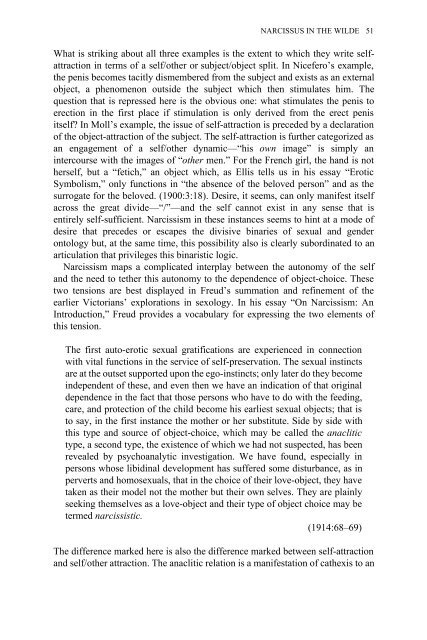Edited by Moe Meyer - Get a Free Blog
Edited by Moe Meyer - Get a Free Blog
Edited by Moe Meyer - Get a Free Blog
You also want an ePaper? Increase the reach of your titles
YUMPU automatically turns print PDFs into web optimized ePapers that Google loves.
NARCISSUS IN THE WILDE 51<br />
What is striking about all three examples is the extent to which they write selfattraction<br />
in terms of a self/other or subject/object split. In Nicefero’s example,<br />
the penis becomes tacitly dismembered from the subject and exists as an external<br />
object, a phenomenon outside the subject which then stimulates him. The<br />
question that is repressed here is the obvious one: what stimulates the penis to<br />
erection in the first place if stimulation is only derived from the erect penis<br />
itself? In Moll’s example, the issue of self-attraction is preceded <strong>by</strong> a declaration<br />
of the object-attraction of the subject. The self-attraction is further categorized as<br />
an engagement of a self/other dynamic—“his own image” is simply an<br />
intercourse with the images of “other men.” For the French girl, the hand is not<br />
herself, but a “fetich,” an object which, as Ellis tells us in his essay “Erotic<br />
Symbolism,” only functions in “the absence of the beloved person” and as the<br />
surrogate for the beloved. (1900:3:18). Desire, it seems, can only manifest itself<br />
across the great divide—“/”—and the self cannot exist in any sense that is<br />
entirely self-sufficient. Narcissism in these instances seems to hint at a mode of<br />
desire that precedes or escapes the divisive binaries of sexual and gender<br />
ontology but, at the same time, this possibility also is clearly subordinated to an<br />
articulation that privileges this binaristic logic.<br />
Narcissism maps a complicated interplay between the autonomy of the self<br />
and the need to tether this autonomy to the dependence of object-choice. These<br />
two tensions are best displayed in Freud’s summation and refinement of the<br />
earlier Victorians’ explorations in sexology. In his essay “On Narcissism: An<br />
Introduction,” Freud provides a vocabulary for expressing the two elements of<br />
this tension.<br />
The first auto-erotic sexual gratifications are experienced in connection<br />
with vital functions in the service of self-preservation. The sexual instincts<br />
are at the outset supported upon the ego-instincts; only later do they become<br />
independent of these, and even then we have an indication of that original<br />
dependence in the fact that those persons who have to do with the feeding,<br />
care, and protection of the child become his earliest sexual objects; that is<br />
to say, in the first instance the mother or her substitute. Side <strong>by</strong> side with<br />
this type and source of object-choice, which may be called the anaclitic<br />
type, a second type, the existence of which we had not suspected, has been<br />
revealed <strong>by</strong> psychoanalytic investigation. We have found, especially in<br />
persons whose libidinal development has suffered some disturbance, as in<br />
perverts and homosexuals, that in the choice of their love-object, they have<br />
taken as their model not the mother but their own selves. They are plainly<br />
seeking themselves as a love-object and their type of object choice may be<br />
termed narcissistic.<br />
(1914:68–69)<br />
The difference marked here is also the difference marked between self-attraction<br />
and self/other attraction. The anaclitic relation is a manifestation of cathexis to an


